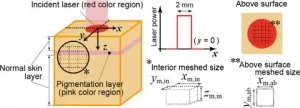(Press-News.org) Until now, historians have treated accounts of extreme weather events that might indicate climate change, or more specifically an increase in rainfall, with suspicion. Too many purely cultural factors, they argue, might have influenced one author or another to write about rains, droughts or floods. A new interdisciplinary study lead by researchers from the University of Pisa and the University of Warsaw, together with an international team of collaborators, links data indicating increased precipitation in northern and central Italy during the 6th century CE to historical accounts contained in contemporaneous texts about the lives and miracles of saints. The paper successfully integrates palaeoclimate proxies with historical records, demonstrating how interdisciplinary studies can provide a better understanding of climate impacts on past societies.
To obtain data about past climates, the researchers examined a stalagmite from Renella Cave in northern Tuscany. Layers of minerals deposited over the centuries provide a record of environmental conditions, much like tree rings, for scientists to analyze. Measuring the ratio of oxygen isotopes in successive layers of the stalagmite allowed the team to distinguished between wetter and drier periods, which they dated using uranium-thorium dating (a method similar to the more widely known radiocarbon method). On this basis, the researchers indicated that the 6th century CE in northern and central Italy was distinguished from others by an exceptional level of moisture.
A likely source of the moisture is a long-lasting negative phase of the North Atlantic Oscillation, a period of reduced atmospheric pressure that inundated northern and central Italy with moist air from the North Atlantic. Because water from the Atlantic has a higher concentration of lighter oxygen isotopes than the average precipitation in northern Italy, the negative North Atlantic Oscillations of the 6th century and associated rainfall in Italy left a telltale isotopic "trace" in the stalagmite layers of Renella Cave.
Unusual phenomena in Italian texts
With the speleothem data in hand, the authors turned to the historical record. Using The Cult of Saints in Antiquity Database, researchers accessed and analyzed more ancient and medieval texts than previously possible. This enabled them to compare sixth century Italian writings against the entirety of late antique and early medieval hagiographic texts (i.e., stories about saints) and identify their unique features.
Sixth-century accounts from the Apennine Peninsula, especially the Dialogues on the Miracles of the Italian Fathers attributed to Pope Gregory the Great, contain many descriptions of so-called water miracles, in which saints bring down or stop violent rains, storms and floods. In hagiographic literature from before and after this period, as well as in the writings of Gregory of Tours, a contemporaneous source that describes events in what is now France, stories of water miracles are almost absent. In the Dialogues they account for almost 20% of all references to miracles, which constitutes a unique feature.
Scholars interpret the sudden appearance of such accounts as proof of an exceptional interest in hydroclimatic events - which must have had a reason. This reason, according to the authors, was the climate change that occurred at the time and manifested itself in increased rainfall and floods.
"Literary sources, in particular stories about saints, should not be taken as a direct record of past events," says Robert Wi?niewski, hagiography specialist and a co-author from the University of Warsaw. "They do, however, reflect the worldview of church writers and the basis for their interpretation of extraordinary weather phenomena."
"In this study, geochemists, geologists, and climate specialists proved a climactic change that written sources only hinted at. In the sixth century, at least part of Italy really did become a land of torrential rains and floods," adds Giovanni Zanchetta, professor of geology from the University of Pisa and the first author of the paper.
Changing climate, changing culture
Above all, the presence of unusual hydrological and climatic events in the writings of sixth-century Italy indicates the role these events may have played in the socio-cultural changes that historians have long acknowledged. Such changes include the assumption local leadership by the bishops at the end of the sixth century and the development of the cult of saints, combined with a belief in their power over disease, people and nature in general.
"In addition to climate change, late Roman Italy also experienced numerous 'barbarian' invasions - but these difficult experiences did not lead the society of the time to collapse. On the contrary, it seems that climatic change actually contributed to strengthening its internal cohesion during a dramatic historical moment," says Kevin Bloomfield, Roman historian and a co-author from Cornell University.
Scholars increasingly acknowledge that climatic phenomena are important factors in the speed and scale of social and cultural change. A "hybrid" approach to the study of climate impacts on past societies, based on both natural and historical data, makes it possible to avoid simplistic, and often catastrophic, interpretations of these impacts and better understand the actual experiences of societies at the time. "Our approach," emphasizes Adam Izdebski, the corresponding author and the leader of the Palaeo-Science and History Independent Research Group at the Max Planck Institute for the Science of Human History, "shows how varied and unpredictable modern society's responses to current climate change and other natural disasters can be."
INFORMATION:
Researchers from Skoltech have developed an early prototype of a medical imaging system that uses neural networks to analyze near-infrared images of veins and project a venous pattern onto a patient's body - this may make blood draws much easier and less of a nuisance for patients with difficult access to veins. The paper was published in the proceedings of the 16th International Conference on Control, Automation, Robotics and Vision (ICARCV).
According to data cited in the paper, out of approximately 20 million blood tests performed globally every day, almost 45% are estimated to involve some degree of discomfort for the patient whose ...
(Boston)--Pregnancy complications affect up to one in three pregnancies and are increasingly linked to future chronic disease. For example, preeclampsia is associated with a doubled risk of cardiovascular disease, the leading cause of death in the U.S., and gestational diabetes is associated with a seven-fold increased risk of type 2 diabetes. While guidelines recommend preventive care starting within the first postpartum year to address such pregnancy-related health risks, the connections between pregnancy health and future health are often neglected.
In ...
An international team of researchers led by a University of Virginia School of Medicine professor is warning that scientists must better prepare for the next pandemic - and has developed a plan to do just that.
Noting the "avalanche" of scientific data generated in response to COVID-19, UVA's Wladek Minor, PhD, and colleagues are calling for the creation of an "advanced information system" (AIS) to help scientists integrate, monitor and evaluate the vast amounts of data that will be produced as researchers reveal the molecular architecture of the next pathogen ...
URBANA, Ill. - Ever thought about buying or building a bat box to help bats? Think carefully about the design and where you put it, University of Illinois researchers say.
Here's why: Bats and their pups can overheat and die in poorly designed or placed bat boxes, and in a warming climate, it could happen more often.
Illinois bat ecologists Joy O'Keefe and Reed Crawford recently synthesized the available data on bat boxes, also known as bat houses or artificial roosts, to raise awareness of the issue and motivate change in bat box design, marketing, and consumer education. Their recommendations are published in Conservation Science and Practice.
"Conservation ...
A pilot human clinical trial conducted by researchers at Baylor College of Medicine reveals that supplementation with GlyNAC - a combination of glycine and N-acetylcysteine as precursors of the natural antioxidant glutathione - could improve many age-associated defects in older humans to improve muscle strength and cognition, and promote healthy aging.
Published in the journal Clinical and Translational Medicine, the results of this study show that older humans taking GlyNAC for 24 weeks saw improvements in many characteristic defects of aging, including ...
In the Arctic, climate change and pollution are the biggest threats to top predators like narwals. Studying the animals' tusks reveals that diet and exposure to pollution have shifted over the past half century in response to sea-ice decline. Human emissions have also led to a sharp rise in the presence of mercury in recent years, according to an international team of researchers.
"Our research shows that climate change is having substantial impacts on Arctic ecosystems, with consequences for exposure to toxic pollutants like mercury," says co-author Jean-Pierre Desforges, a Postdoctoral Fellow at McGill University under the supervision ...
Alexandria, Va., USA -- Asymptomatic carriage of SARS-CoV-2 is a potentially significant source of transmission, yet remains relatively poorly understood. The study "SARS-CoV-2 Positivity in Asymptomatic-screened Dental Patients" published in the Journal of Dental Research (JDR), investigated SARS-CoV-2 infection in asymptomatic dental patients to inform community surveillance and improve understanding of risks in the dental setting.
Thirty-one dental care centers across Scotland invited asymptomatic screened patients over the age of five to participate. During the patient visit, trained ...
Laser treatment is now commonplace across various fields of medicine including dermatology, where it is commonly used to remove scars, wrinkles, and freckles. The technology, however, has a major downside: despite continued improvements, medical accidents related to laser treatment has been on the rise, with studies revealing excessively high laser energy as the major cause of such accidents.
Assistant Professor Takahiro Kono from Shibaura Institute of Technology (SIT), Japan, whose research is focused on the mechanism of heat transfer involved in the interaction of laser light with biological tissue explains, "The difficulty lies in adjusting the laser conditions for each patient ...
A team of researchers led by UCL Great Ormond Street Institute of Child Health (ICH) and Great Ormond Street Hospital (GOSH) has found that metformin - a drug commonly used to treat Type 2 diabetes - can successfully reduce symptoms associated with tuberous sclerosis complex (TSC), including reduction in the frequency of seizures and the size of brain tumours.
The study, which also included teams from Royal United Hospitals Bath NHS Foundation Trust (RUH) and University Hospitals Bristol and Weston NHS Foundation Trust, recruited 51 patients with TSC who were randomly assigned a placebo or metformin for one year on a dose similar to that given for Type 2 diabetes.
TSC is a genetic disorder characterised ...
In order to develop more effective drugs against a range of cancers, researchers have been investigating the molecular structure of many diseased-linked enzymes in the body. An intriguing case in point is Taspase 1, a type of enzyme known as a protease. The primary duty of proteases is to break down proteins into smaller peptide snippets or single amino acids.
Taspase 1 appears to play a vital role in a range of physiological processes, including cell metabolism, proliferation, migration and termination. The normal functioning of Taspase 1 can go awry however, leading to a range of diseases, including leukemia, colon and breast cancers, as well as glioblastoma, a particularly lethal and incurable malignancy in the brain.
Because Taspase 1 dysregulation is increasingly ...




